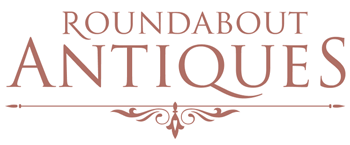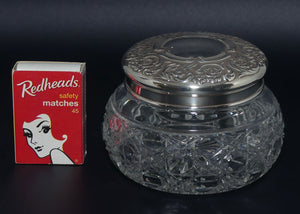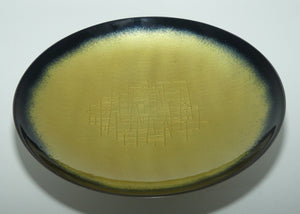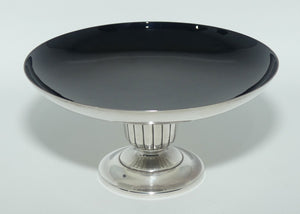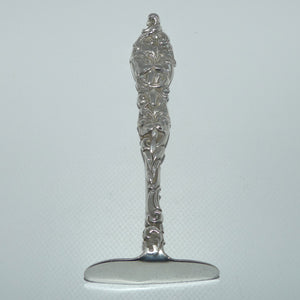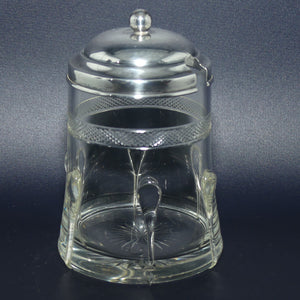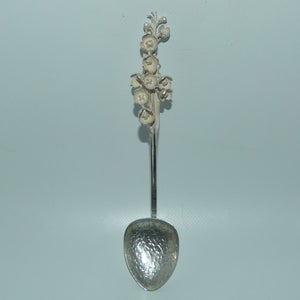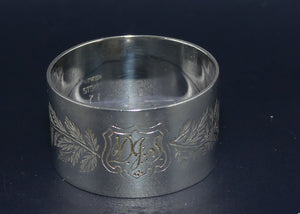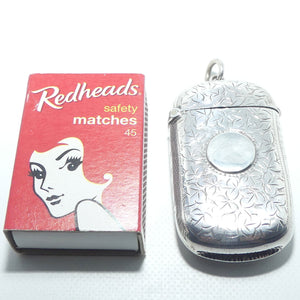{"id":8116380074212,"title":"Georgian | Geo III | Sterling Silver pair of Old English pattern soup or serving spoons | Newcastle 1802 | John Langlands","handle":"george-iii-sterling-silver-pair-of-old-english-pattern-soup-or-serving-spoons-newcastle-1802-john-langlands-1","description":"George III Sterling Silver pair of Old English pattern soup or serving spoons\u003cbr\u003e\u003cbr\u003eMaker: John Langlands\u003cbr\u003eAssay: Newcastle 1802\u003cbr\u003eFamily Initials MJS to top of both spoons in Scrolled Italic engraving\u003cbr\u003e\u003cbr\u003eWeight: 104g the pair\u003cbr\u003e\u003cbr\u003eApprox 21cms (8 1\/4\") long\u003cbr\u003eApprox 4.5cms (1 3\/4\") wide at widest\u003cbr\u003e\u003cbr\u003eIn excellent condition\u003cbr\u003eGUARANTEED free from damage and repair\u003cbr\u003e\u003cbr\u003e\u003cstrong\u003eNewcastle Hallmarks are scarcer\u003c\/strong\u003e\u003cbr\u003e\n\u003cp class=\"txt3\" data-mce-fragment=\"1\"\u003eNewcastle goldsmiths were producing silver throughout the Middle Ages but the Newcastle assay office was not officially established until 1702 when an amendment to the 1701 Act of Parliament establishing provincial assay offices was passed (Newcastle having been omitted from the original list). The town mark was derived from the Newcastle arms, being three castles.\u003c\/p\u003e\n\u003cp class=\"txt3\" data-mce-fragment=\"1\"\u003eIn theory the date letter should have been changed in May each year when the new wardens were appointed for the following year, but there is evidence that various date letter punches were not ordered from the engraver until much later in some years. In addition, prior to 1773, the assay master and the wardens were not always punctilious about changing the date letter annually or in strict alphabetical sequence.\u003c\/p\u003e\n\u003cp class=\"txt3\" data-mce-fragment=\"1\"\u003eNewcastle gold and silver production reached a peak in 1815 but declined from then onwards and in 1884, at a meeting of the Goldsmiths' Company, it was proposed that the assay office be wound up. The final dies were destroyed in June of that year.\u003c\/p\u003e\n\u003cstrong\u003eAbout John Langlands\u003c\/strong\u003e\u003cbr\u003e\u003cspan data-mce-fragment=\"1\"\u003eJohn Langlands was a Newcastle based silversmith. He was part of the Langlands family who were the largest silver-plate producers in Newcastle for 60 years. John Langlands started in partnership with John Goodrick, taking over the business of their master Isaac Cookson when he died in 1754. When Goodrick died in 1757, Langlands carried on and the business continued to thrive. He went into partnership with John Robertson I in 1778 until 1795. When the partnership was dissolved (two years after his death in 1793), his wife, Margaret, ran things in the meantime. Langlands son, Robert II, took over the business and it continued to produce high quality silver plate. His widow Dorothy took over after his death in 1804 and continued until her retirement in 1814. The Langlands and Robertson partnership was very prolific, and they became renowned sugar tong makers rivalling good London producers of the same period. They entered marks in 1778 and 1780 and continued to use both, so dating their pieces can be difficult on marks alone.\u003c\/span\u003e\u003cbr\u003e","published_at":"2023-12-30T06:00:17+10:00","created_at":"2023-12-29T12:24:22+10:00","vendor":"Sterling Silver","type":"Soup Spoons","tags":["Era_George III","Era_Georgian","Georgian","Type_English Sterling Silver"],"price":25000,"price_min":25000,"price_max":25000,"available":true,"price_varies":false,"compare_at_price":null,"compare_at_price_min":0,"compare_at_price_max":0,"compare_at_price_varies":false,"variants":[{"id":44446446551268,"title":"Default Title","option1":"Default Title","option2":null,"option3":null,"sku":"232402028C","requires_shipping":true,"taxable":true,"featured_image":null,"available":true,"name":"Georgian | Geo III | Sterling Silver pair of Old English pattern soup or serving spoons | Newcastle 1802 | John Langlands","public_title":null,"options":["Default Title"],"price":25000,"weight":1000,"compare_at_price":null,"inventory_management":"shopify","barcode":null,"requires_selling_plan":false,"selling_plan_allocations":[]}],"images":["\/\/www.roundaboutantiques.com.au\/cdn\/shop\/files\/1802_langlands_pair_1a_43c9f913-2e4b-48ec-b104-f8bca20fc9a3.jpg?v=1703816671","\/\/www.roundaboutantiques.com.au\/cdn\/shop\/files\/1802_langlands_pair_1b_54ecfd95-c8fe-4ba4-b9c2-d47c883533dc.jpg?v=1703816671","\/\/www.roundaboutantiques.com.au\/cdn\/shop\/files\/1802_langlands_pair_1c_189f83d9-4ead-4112-a99b-2744f367623b.jpg?v=1703816671","\/\/www.roundaboutantiques.com.au\/cdn\/shop\/files\/1802_langlands_pair_1d_1dc89638-1d69-4d28-a774-7c4e79df5d7c.jpg?v=1703816672","\/\/www.roundaboutantiques.com.au\/cdn\/shop\/files\/1802_langlands_pair_1e_d03a3a97-18af-499d-8066-6ef8cdf12363.jpg?v=1703816672"],"featured_image":"\/\/www.roundaboutantiques.com.au\/cdn\/shop\/files\/1802_langlands_pair_1a_43c9f913-2e4b-48ec-b104-f8bca20fc9a3.jpg?v=1703816671","options":["Title"],"media":[{"alt":"George III Sterling Silver pair of Old English pattern soup or serving spoons | Newcastle 1802 | John Langlands","id":56282976649444,"position":1,"preview_image":{"aspect_ratio":1.399,"height":1072,"width":1500,"src":"\/\/www.roundaboutantiques.com.au\/cdn\/shop\/files\/1802_langlands_pair_1a_43c9f913-2e4b-48ec-b104-f8bca20fc9a3.jpg?v=1703816671"},"aspect_ratio":1.399,"height":1072,"media_type":"image","src":"\/\/www.roundaboutantiques.com.au\/cdn\/shop\/files\/1802_langlands_pair_1a_43c9f913-2e4b-48ec-b104-f8bca20fc9a3.jpg?v=1703816671","width":1500},{"alt":"George III Sterling Silver pair of Old English pattern soup or serving spoons | Newcastle 1802 | John Langlands","id":56282976682212,"position":2,"preview_image":{"aspect_ratio":0.714,"height":1500,"width":1071,"src":"\/\/www.roundaboutantiques.com.au\/cdn\/shop\/files\/1802_langlands_pair_1b_54ecfd95-c8fe-4ba4-b9c2-d47c883533dc.jpg?v=1703816671"},"aspect_ratio":0.714,"height":1500,"media_type":"image","src":"\/\/www.roundaboutantiques.com.au\/cdn\/shop\/files\/1802_langlands_pair_1b_54ecfd95-c8fe-4ba4-b9c2-d47c883533dc.jpg?v=1703816671","width":1071},{"alt":"George III Sterling Silver pair of Old English pattern soup or serving spoons | Newcastle 1802 | John Langlands","id":56282976714980,"position":3,"preview_image":{"aspect_ratio":1.401,"height":1071,"width":1500,"src":"\/\/www.roundaboutantiques.com.au\/cdn\/shop\/files\/1802_langlands_pair_1c_189f83d9-4ead-4112-a99b-2744f367623b.jpg?v=1703816671"},"aspect_ratio":1.401,"height":1071,"media_type":"image","src":"\/\/www.roundaboutantiques.com.au\/cdn\/shop\/files\/1802_langlands_pair_1c_189f83d9-4ead-4112-a99b-2744f367623b.jpg?v=1703816671","width":1500},{"alt":"George III Sterling Silver pair of Old English pattern soup or serving spoons | Newcastle 1802 | John Langlands","id":56282976747748,"position":4,"preview_image":{"aspect_ratio":1.399,"height":1072,"width":1500,"src":"\/\/www.roundaboutantiques.com.au\/cdn\/shop\/files\/1802_langlands_pair_1d_1dc89638-1d69-4d28-a774-7c4e79df5d7c.jpg?v=1703816672"},"aspect_ratio":1.399,"height":1072,"media_type":"image","src":"\/\/www.roundaboutantiques.com.au\/cdn\/shop\/files\/1802_langlands_pair_1d_1dc89638-1d69-4d28-a774-7c4e79df5d7c.jpg?v=1703816672","width":1500},{"alt":null,"id":56282976780516,"position":5,"preview_image":{"aspect_ratio":1.401,"height":1071,"width":1500,"src":"\/\/www.roundaboutantiques.com.au\/cdn\/shop\/files\/1802_langlands_pair_1e_d03a3a97-18af-499d-8066-6ef8cdf12363.jpg?v=1703816672"},"aspect_ratio":1.401,"height":1071,"media_type":"image","src":"\/\/www.roundaboutantiques.com.au\/cdn\/shop\/files\/1802_langlands_pair_1e_d03a3a97-18af-499d-8066-6ef8cdf12363.jpg?v=1703816672","width":1500}],"requires_selling_plan":false,"selling_plan_groups":[],"content":"George III Sterling Silver pair of Old English pattern soup or serving spoons\u003cbr\u003e\u003cbr\u003eMaker: John Langlands\u003cbr\u003eAssay: Newcastle 1802\u003cbr\u003eFamily Initials MJS to top of both spoons in Scrolled Italic engraving\u003cbr\u003e\u003cbr\u003eWeight: 104g the pair\u003cbr\u003e\u003cbr\u003eApprox 21cms (8 1\/4\") long\u003cbr\u003eApprox 4.5cms (1 3\/4\") wide at widest\u003cbr\u003e\u003cbr\u003eIn excellent condition\u003cbr\u003eGUARANTEED free from damage and repair\u003cbr\u003e\u003cbr\u003e\u003cstrong\u003eNewcastle Hallmarks are scarcer\u003c\/strong\u003e\u003cbr\u003e\n\u003cp class=\"txt3\" data-mce-fragment=\"1\"\u003eNewcastle goldsmiths were producing silver throughout the Middle Ages but the Newcastle assay office was not officially established until 1702 when an amendment to the 1701 Act of Parliament establishing provincial assay offices was passed (Newcastle having been omitted from the original list). The town mark was derived from the Newcastle arms, being three castles.\u003c\/p\u003e\n\u003cp class=\"txt3\" data-mce-fragment=\"1\"\u003eIn theory the date letter should have been changed in May each year when the new wardens were appointed for the following year, but there is evidence that various date letter punches were not ordered from the engraver until much later in some years. In addition, prior to 1773, the assay master and the wardens were not always punctilious about changing the date letter annually or in strict alphabetical sequence.\u003c\/p\u003e\n\u003cp class=\"txt3\" data-mce-fragment=\"1\"\u003eNewcastle gold and silver production reached a peak in 1815 but declined from then onwards and in 1884, at a meeting of the Goldsmiths' Company, it was proposed that the assay office be wound up. The final dies were destroyed in June of that year.\u003c\/p\u003e\n\u003cstrong\u003eAbout John Langlands\u003c\/strong\u003e\u003cbr\u003e\u003cspan data-mce-fragment=\"1\"\u003eJohn Langlands was a Newcastle based silversmith. He was part of the Langlands family who were the largest silver-plate producers in Newcastle for 60 years. John Langlands started in partnership with John Goodrick, taking over the business of their master Isaac Cookson when he died in 1754. When Goodrick died in 1757, Langlands carried on and the business continued to thrive. He went into partnership with John Robertson I in 1778 until 1795. When the partnership was dissolved (two years after his death in 1793), his wife, Margaret, ran things in the meantime. Langlands son, Robert II, took over the business and it continued to produce high quality silver plate. His widow Dorothy took over after his death in 1804 and continued until her retirement in 1814. The Langlands and Robertson partnership was very prolific, and they became renowned sugar tong makers rivalling good London producers of the same period. They entered marks in 1778 and 1780 and continued to use both, so dating their pieces can be difficult on marks alone.\u003c\/span\u003e\u003cbr\u003e"}
